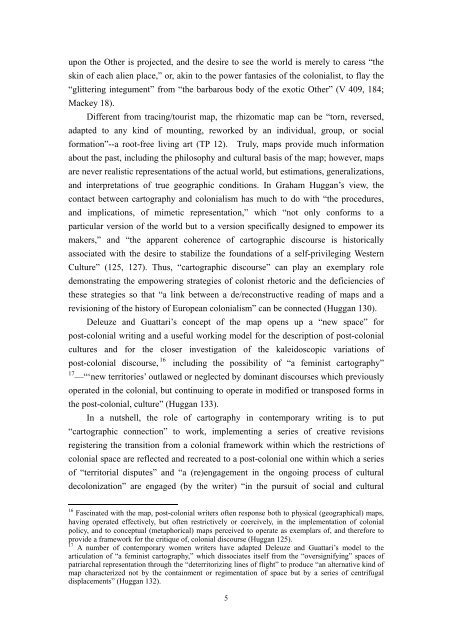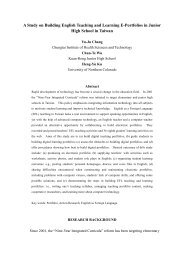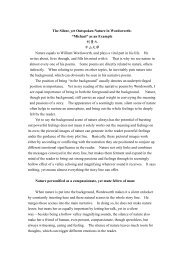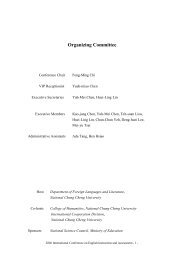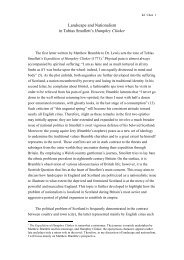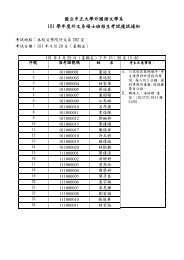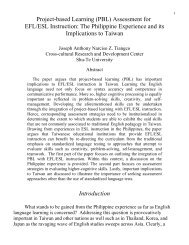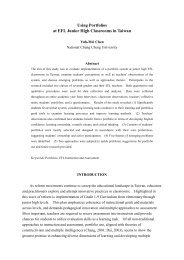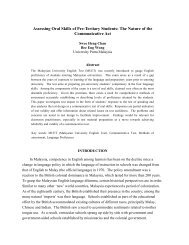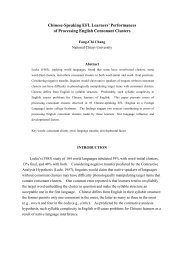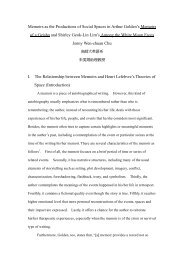V'scape?A Deleuzean Reading of V.
V'scape?A Deleuzean Reading of V.
V'scape?A Deleuzean Reading of V.
You also want an ePaper? Increase the reach of your titles
YUMPU automatically turns print PDFs into web optimized ePapers that Google loves.
upon the Other is projected, and the desire to see the world is merely to caress “the<br />
skin <strong>of</strong> each alien place,” or, akin to the power fantasies <strong>of</strong> the colonialist, to flay the<br />
“glittering integument” from “the barbarous body <strong>of</strong> the exotic Other” (V 409, 184;<br />
Mackey 18).<br />
Different from tracing/tourist map, the rhizomatic map can be “torn, reversed,<br />
adapted<br />
to any kind <strong>of</strong> mounting, reworked by an individual, group, or social<br />
formation”--a root-free living art (TP 12). Truly, maps provide much information<br />
about the past, including the philosophy and cultural basis <strong>of</strong> the map; however, maps<br />
are never realistic representations <strong>of</strong> the actual world, but estimations, generalizations,<br />
and interpretations <strong>of</strong> true geographic conditions. In Graham Huggan’s view, the<br />
contact between cartography and colonialism has much to do with “the procedures,<br />
and implications, <strong>of</strong> mimetic representation,” which “not only conforms to a<br />
particular version <strong>of</strong> the world but to a version specifically designed to empower its<br />
makers,” and “the apparent coherence <strong>of</strong> cartographic discourse is historically<br />
associated with the desire to stabilize the foundations <strong>of</strong> a self-privileging Western<br />
Culture” (125, 127). Thus, “cartographic discourse” can play an exemplary role<br />
demonstrating the empowering strategies <strong>of</strong> colonist rhetoric and the deficiencies <strong>of</strong><br />
these strategies so that “a link between a de/reconstructive reading <strong>of</strong> maps and a<br />
revisioning <strong>of</strong> the history <strong>of</strong> European colonialism” can be connected (Huggan 130).<br />
Deleuze and Guattari’s concept <strong>of</strong> the map opens up a “new space” for<br />
post- colonial writing and a useful working model for the description <strong>of</strong> post-colonial<br />
cultures and for the closer investigation <strong>of</strong> the kaleidoscopic variations <strong>of</strong><br />
post-colonial discourse, 16 including the possibility <strong>of</strong> “a feminist cartography”<br />
17 —“‘new territories’ outlawed or neglected by dominant discourses which previously<br />
operated in the colonial, but continuing to operate in modified or transposed forms in<br />
the post-colonial, culture” (Huggan 133).<br />
In a nutshell, the role <strong>of</strong> cartography<br />
in contemporary writing is to put<br />
“cartographic<br />
connection” to work, implementing a series <strong>of</strong> creative revisions<br />
registering the transition from a colonial framework within which the restrictions <strong>of</strong><br />
colonial space are reflected and recreated to a post-colonial one within which a series<br />
<strong>of</strong> “territorial disputes” and “a (re)engagement in the ongoing process <strong>of</strong> cultural<br />
decolonization” are engaged (by the writer) “in the pursuit <strong>of</strong> social and cultural<br />
16 Fascinated with the map, post-colonial writers <strong>of</strong>ten response both to physical (geographical) maps,<br />
having operated effectively, but <strong>of</strong>ten restrictively or coercively, in the implementation <strong>of</strong> colonial<br />
policy, and to conceptual (metaphorical) maps perceived to operate as exemplars <strong>of</strong>, and therefore to<br />
provide a framework for the critique <strong>of</strong>, colonial discourse (Huggan 125).<br />
17 A number <strong>of</strong> contemporary women writers have adapted Deleuze and Guattari’s model to the<br />
articulation <strong>of</strong> “a feminist cartography,” which dissociates itself from the “oversignifying” spaces <strong>of</strong><br />
patriarchal representation through the “deterritorizing lines <strong>of</strong> flight” to produce “an alternative kind <strong>of</strong><br />
map characterized not by the containment or regimentation <strong>of</strong> space but by a series <strong>of</strong> centrifugal<br />
displacements” (Huggan 132).<br />
5


